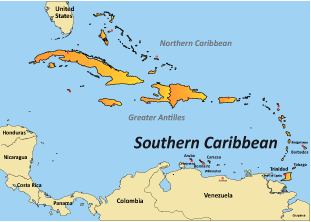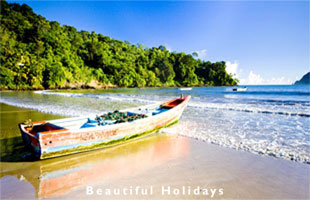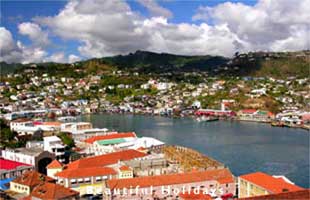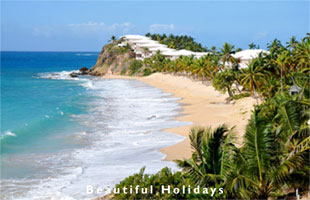Lesser Antilles Holidays
The Caribbean

The Lesser Antilles is a curving arch of small islands along the eastern flank of the Caribbean Sea. The string of islands extend south from Puerto Rico, the eastern island of the Greatter Antilles, reaching right down to South America where Trinidad & Tobago almost touches the Venezela coast. The Caribbean Sea lies to the north and west of the island nations, the Atlantic Ocean to the east, and the Gulf of Paria to the south. All of the Southern Caribbean islands are either volcanic or made of limestone coral, forming as they did at the ridge of the Caribbean and South American tectonic plates. Due to the close proximity of the equator, the Southern Caribbean has all year around tropical weather. Most of the islands are in the Windward Islands chain and the Netherlands Antilles. The majority of the islands are covered in tropical rainforests that make for excellent hiking and zip-lining.

Map of Lesser Antilles
The Lesser Antilles is part of the West Indies and include:
Leeward Islands (north-east)
Windward Islands (south-west):
Southern Carribbean (the ABC)
Leward Islands
About half the Leeward Islands are low, flat, coral islands with dry desert vegetation including the beautiful British Virgin Islands and upmarket St Barts. The other half, including Saba, St. Eustatia, St. Kitts, Nevis, and Guadeloupe (to the south and west), are tall, volcanic lands with lush tropical rainforests and volcanoes in various stages of activity. This is likely because the two island chains sit on two different tectonic plates. As a group or separately, the Leeward Islands are some of the most popular vacation destinations in the world. Regardless of topography, flora or fauna, they all have comfortably high temperatures all year, and the diving, swimming, surfing, fishing, sailing, and snorkeling are incredible; the indigenous plants, animals and birds on all the islands are definitely time- and camera-worthy.
Windward Islands
The Windward Islands on the south-eastern edge of the Caribbean Sea consist of Dominica, Martinique, St. Lucia, St. Vincent and the Grenadines, and Grenada. The area is called the Windward Islands (exposed to the wind) because ships in the 1700s bound for Jamaica followed the trade-wind passage, stopping at islands along the way. These islands are a north-south chain in the southern section of the Lesser Antilles; they are all volcanic rock formations.
Dominica. The "Nature Island" of Dominica (Domin-eek-ah) is home to 10 of the 20 active volcanoes in the Eastern Caribbean, and is the youngest island in the Lesser Antilles. If you're looking for soft sandy beaches, fun in the sun, crowds of boisterous tourists, and miles of shopping opportunities, stay away from Dominica. This place is an eco-friendly, nature-lover's dream-come-true. But you have to be in fairly good shape to explore it all—it's almost all mountains and rain-forests, with a few isolated black-sand beaches in the northeast, a bit like an ecosystem still in the process of forming.
Martinique is still a French possession. The island is dotted with volcanoes, dormant but for Mount Pelée, which is the highest at 1,397 metres. Volcanic ash from Pelée has painted the beaches of the north in shades of gray and black, in sharp contrast to the ultra-white sands in the south. Often called the 'Isle of Flowers,' with botanical gardens tucked here and there in the rugged landscape, Martinique is a 'something for everyone' destination, with sophisticated pleasures, gastronomic delights, mind-blowing diving sites and sights, and extreme shopping therapy. Tropical conditions in Martinique have helped cover the island with vegetation, including lush tropical forests, savannas, fruits, plants, and flowers, plus the incredible mangrove forests; together this vegetation turns the island into a veritable Garden of Eden.
Saint Lucia is a little slice of heaven located where the Caribbean Sea meets the Atlantic Ocean in the Lesser Antilles. A small volcanic island, it is more mountainous than most other islands in the Caribbean; the highest point is Mount Gimie, 950 metres above sea level that, with two other famous mountains, the Pitons, form the island's most famous landmark. This tropical island is a favorite honeymoon spot, and offers weary travelers relaxing beaches, mountains to hike, exotic plants, animals, and birds to watch and capture on film or canvas, and the Qualibou volcano, one of the few drive-in volcanoes in the world, with its boiling, rejuvenating sulfur springs.
Anguilla (UK),
Saint Martin (Fr.),
Saint Barts (Fr.),
Saba (Neth.),
Montserrat (UK),
Guadeloupe (Fr.)
Dominica (Commonwealth)
Martinique (Fr.)
The Southern Caribbean
Flanking the coast of Venezuala rae the three southern islands of Aruba, Bonaire, and Curaçao, often referred to as the Dutch Antilles. They are often referred to as the ABC Islands. Their tropical marine climate tempts visitors to the islands 365 days each year. Aruba is one of the top five windsurfing and kite surfing destinations in the world, with crazy waves and trade winds that average up to fifteen knots.
Bonaire is so quiet and peaceful there are no traffic lights anywhere on the island. It is home to three of the world's seven species of sea turtles: Green and hawksbill turtles are found in the seas around Bonaire all year, and the big-headed loggerheads generally only visit during nesting season. Bonaire is quiet, peaceful, relaxing and lightly populated; the flamingo population almost beats the human population most days.
The largest and most populous of the ABC islands, Curaçao attracts divers to the Mushroom Forest, an underwater jungle of 10-foot, mushroom-shaped star coral, and hikers to the Hato Caves, an elaborate system of stalagmites and stalactites decorated with 1,500-year-old cave paintings.



